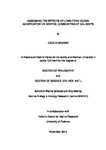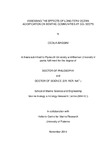Assessing the effects of long-term ocean acidification on benthic communities at CO2 seeps
| dc.contributor.supervisor | Hall-Spencer, Jason | |
| dc.contributor.author | Baggini, Cecilia | |
| dc.contributor.other | School of Biological and Marine Sciences | en_US |
| dc.date.accessioned | 2015-04-22T11:22:43Z | |
| dc.date.available | 2015-04-22T11:22:43Z | |
| dc.date.issued | 2015 | |
| dc.date.issued | 2015 | |
| dc.identifier | 10266150 | en_US |
| dc.identifier.uri | http://hdl.handle.net/10026.1/3321 | |
| dc.description | Full version unavailable due to 3rd party copyright restrictions. | |
| dc.description.abstract |
Ocean acidification has the potential to profoundly affect marine ecosystems before the end of this century, but there are large uncertainties on its effects on temperate benthic communities. Volcanic CO2 seeps provide an opportunity to examine and improve our understanding of community responses to ocean acidification. In this thesis, two Mediterranean CO2 seeps (Methana in Greece and Vulcano in Italy) were used to investigate the responses of macroalgae and their epifaunal communities to increased CO2. Changes in plant-herbivore interactions at elevated CO2, as well as adaptation potential of dominant macroalgae and responses of macroalgae and epifauna to concurrent exposure to elevated CO2 and copper pollution, were also examined. Firstly, I determined that volcanic seeps off Methana (Greece) are suitable for ocean acidification studies as they do not have confounding gradients in temperature, salinity, total alkalinity, nutrients, hydrogen sulphide, heavy metals or wave exposure. Calcifying macroalgae abundance decreased as CO2 increased both at Methana and at Vulcano, while fucoid algae seemed to benefit from elevated pCO2 levels. Seasonality greatly affected macroalgal responses to increasing CO2, according to the annual cycles of dominant species. Epifaunal communities of dominant fucoid algae changed at elevated pCO2 as well, with calcifying invertebrates decreasing and polychaetes increasing near the seeps. Herbivore control of macroalgal biomass did not greatly change at elevated pCO2 levels, as limpets had a minor role in controlling macroalgal biomass off Vulcano (Italy) and sea urchins were replaced by herbivorous fish near seeps off Methana. The two macroalgal species examined for signs of long-term acclimatisation (Cystoseira corniculata (Turner) Zanardini and Jania rubens (Linnaeus) J.V.Lamouroux) to ocean acidification using reciprocal transplants did not appear to have permanently acclimatised to elevated pCO2 levels, but changed their physiology in four to nine months depending on the local environment. Furthermore, when exposed to a 36-hour copper pulse at elevated pCO2 levels both seaweed species accumulated more copper in their tissues compared to those exposed to copper in reference pCO2 conditions, and this resulted in altered epifaunal assemblages on C. corniculata. These observations suggest that benthic communities will significantly change as CO2 levels increase, and that long-term acclimatisation is not likely to play a significant role; this would have profound consequences for benthic ecosystems and the services they provide. | en_US |
| dc.description.sponsorship | This work was funded through a MARES Grant. MARES is a Joint Doctorate programme selected under Erasmus Mundus coordinated by Ghent University (FPA 2011-0016). | en_US |
| dc.language.iso | en | en_US |
| dc.publisher | Plymouth University | en_US |
| dc.subject | Ocean Acidification | en_US |
| dc.subject | Macroalgae | en_US |
| dc.subject | Biological Communities | en_US |
| dc.subject | Seasonality | en_US |
| dc.subject | Herbivory | en_US |
| dc.title | Assessing the effects of long-term ocean acidification on benthic communities at CO2 seeps | en_US |
| dc.type | Thesis | |
| plymouth.version | Edited version | en_US |
| dc.identifier.doi | http://dx.doi.org/10.24382/3890 |
Files in this item
This item appears in the following Collection(s)
-
01 Research Theses Main Collection
Research Theses Main



